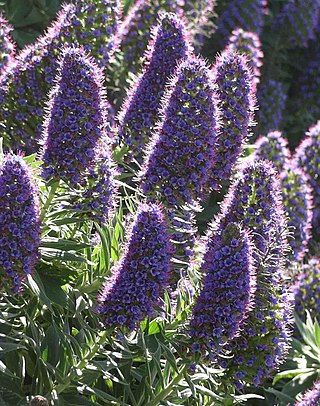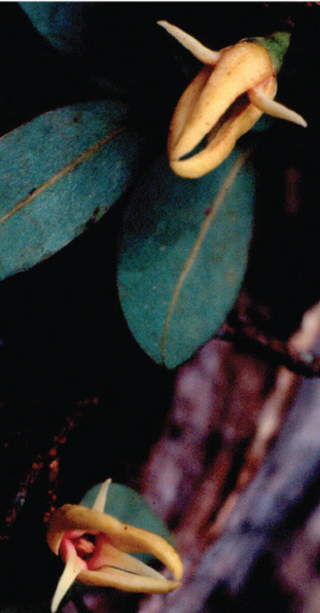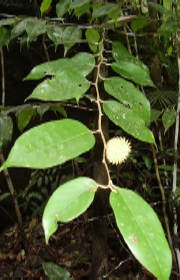
Quercus montana, the chestnut oak, is a species of oak in the white oak group, Quercus sect. Quercus. It is native to the eastern United States, where it is one of the most important ridgetop trees from southern Maine southwest to central Mississippi, with an outlying northwestern population in southern Michigan. It is also sometimes called rock oak because of its presence in montane and other rocky habitats.

Carpinus caroliniana, the American hornbeam, is a small hardwood understory tree in the genus Carpinus. American hornbeam is also known as blue-beech, ironwood, musclewood and muscle beech. It is native to eastern North America, from Minnesota and southern Ontario east to Maine, and south to eastern Texas and northern Florida. It also grows in Canada. It occurs naturally in shaded areas with moist soil, particularly near the banks of streams or rivers, and is often a natural constituent understory species of the riverine and maritime forests of eastern temperate North America.

Quercus imbricaria, the shingle oak, is a deciduous tree in the red oak group of oaks. It is native primarily to the Midwestern and Upper South regions of North America.

Echium candicans, the 'Pride of Madeira', is a species of flowering plant in the family Boraginaceae, and genus Echium, native to the island of Madeira. It is a large herbaceous perennial subshrub, growing to 1.5–2.5 m.

Bougainvillea glabra, the lesser bougainvillea or paperflower, is the most common species of bougainvillea used for bonsai. The epithet 'glabra' comes from Latin and means "bald".
Mitrephora fragrans is a species of plant in the family Annonaceae. It is native to Borneo and The Philippines. Elmer Drew Merrill, the American botanist who first formally described the species, named it after its large, fragrant flowers.
Pittosporum virgatum is a species of plant in the Pittosporaceae family. It is endemic to New Zealand.
Guijo is a species of plant in the family Dipterocarpaceae. It is a tree found in Cambodia, Laos, Vietnam, Sumatra, Peninsular Malaysia, Borneo and the Philippines. The name guijo is a Philippine Spanish word derived from the Tagalog gihò. This is also sometimes known as red balan or red balau sharing its name with Shorea balangeran. Other local names include yamban-yamban in Zambales and taralai in Tarlac.

Deutzia gracilis, the slender deutzia or Japanese snow flower, is a species of flowering plant in the hydrangea family Hydrangeaceae, native to Japan.
Saurauia klemmei is a species of plant in the family Actinidiaceae. It is native to the Philippines. Elmer Drew Merrill, the American botanist who first formally described the species, named it after Wilhelm Klemme, a German forest officer, who collected the specimen Merrill examined from Luzon island in the Philippines.
Goniothalamus nitidus is a species of plant in the family Annonaceae. It is native to Borneo. Elmer Drew Merrill, the American botanist who first formally described the species, named it after its shining leaves.

Lonicera acuminata, commonly known as fragrant grove honeysuckle or vine honeysuckle, is a plant species of honeysuckle native to China to Southeast Asia and India.
Salix chikungensis is a shrub in the willow genus Salix with tomentose hairy and later balding branches. The leaf blades have lengths of 6 to 8.5 centimeters. The natural range of the species is in China.
Salix daguanensis is a shrub in the willow genus Salix with 4 to 8 centimeter long leaf blades. The natural range of the species is in China.
Salix daliensis is a shrub from the genus of willows (Salix) with mostly 5 to 6 centimeters long leaf blades. The natural range of the species is in China.
Salix dissa is a low shrub from the genus willow (Salix) with usually 1 to 3 centimeters long leaf blades. The natural range of the species is in China.
Larsenianthus arunachalensis is a species of the genus Larsenianthus in the ginger family (Zingiberaceae).. It was first described in 2010 and is native to northeastern India, and Myanmar.

Uvariastrum hexaloboides is a species of plant in the Annonaceae family. It is native to Tanzania, Zambia and Zaire. Robert Elias Fries, the botanist who first formally described the species using the basionym Uvaria hexaloboides, named it after a different species Hexalobus monopetalus which he thought its flowers and vegetative parts resembled.

Uvariastrum insculptum is a species of plant in the Annonaceae. It is native to Cameroon, Gabon, Ghana, Ivory Coast, Liberia, Nigeria, and the Republic of the Congo. Adolf Engler and Ludwig Diels, the botanists who first formally described the species using the basionym Uvaria insculpta, named it after the secondary veins on its leaves which are distinctly sunken.

Xylopia arenaria is a species of plant in the Annonaceae family. It is native to Kenya, and Tanzania. Adolf Engler, the botanist who first formally described the species, named it after its growth in sandy places.











